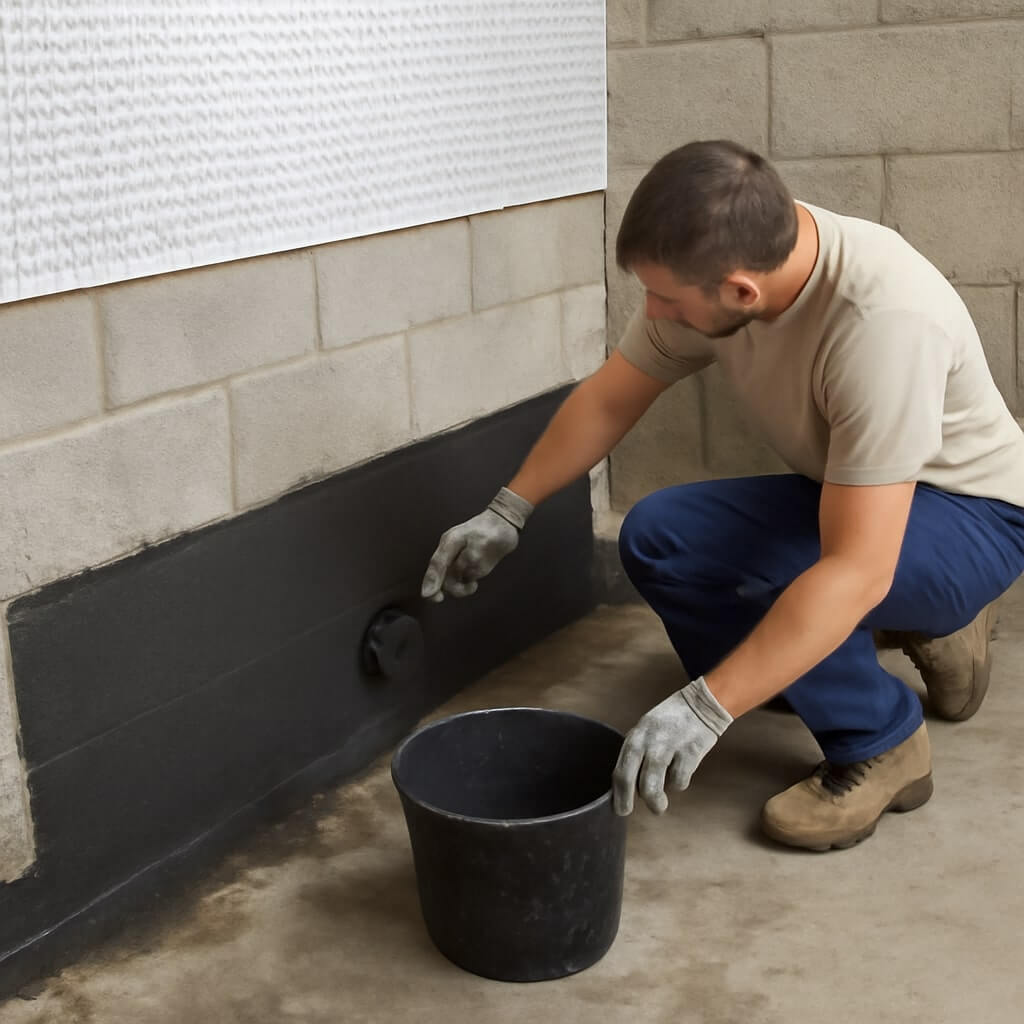When it comes to basement waterproofing in Jackson, you’ve got to assess your basement’s vulnerabilities first. Look for cracks in the foundation and consider how water flows around your property. Choosing the right waterproofing method is essential, as it can prevent costly damage down the line. But that’s just the beginning; understanding the various systems and techniques available can make all the difference in keeping your basement dry. Let’s explore these strategies further.
Key Takeaways
- Inspect your basement foundation regularly for cracks and gaps to prevent moisture intrusion.
- Ensure proper grading around your home’s exterior to direct water away from the foundation.
- Choose the right waterproofing method, balancing DIY options with professional services based on project complexity.
- Install an interior drainage system like a French drain to effectively manage water accumulation.
- Maintain humidity levels below 60% with dehumidifiers and ensure proper ventilation to prevent mold growth.
Assessing Your Basement’s Vulnerability
How can you determine if your basement is vulnerable to water intrusion? Start with a thorough vulnerability assessment.
Inspect the foundation for cracks and gaps, which may allow moisture sources, like rainwater or groundwater, to seep in. Check for improper grading around the exterior, ensuring water drains away from your home.
Examine the interior for signs of dampness, mold, or mildew, which indicate moisture problems. Don’t forget to inspect windows and doors for seal integrity.
Choosing the Right Waterproofing Method
When choosing the right waterproofing method, you’ll need to weigh interior solutions against exterior options.
Consider whether you want to tackle the project yourself or hire professionals, as both paths have distinct advantages and challenges.
Understanding these factors will help you make an informed decision that best suits your basement’s needs.
Interior vs. Exterior Solutions
Which waterproofing method is best for your basement: interior or exterior solutions?
Interior barriers, such as sealants and drainage systems, manage moisture after it enters your space, making them effective for minor issues. However, they don’t address the root cause.
On the other hand, exterior membranes prevent water from reaching your foundation by creating a barrier outside. This method is proactive and often more effective for severe water problems.
Consider your basement’s specific needs, moisture levels, and potential sources of water intrusion when deciding, as choosing the right method can save you from costly repairs down the line.
DIY vs. Professional Services
Choosing between DIY methods and professional services for basement waterproofing involves evaluating your skills, the severity of the moisture issue, and the complexity of the solutions.
DIY techniques, such as applying sealants or installing drainage systems, can be cost-effective but require a solid understanding of the underlying problems.
However, if you’re facing significant water intrusion or structural concerns, professional services may be necessary.
While professional costs can be higher, they often include warranties and expertise that guarantee long-lasting results.
Weigh your options carefully to determine the best approach for your situation and avoid costly mistakes down the line.
Installing Interior Drainage Systems
When you’re installing an interior drainage system, it’s essential to understand the different types available, such as French drains and sump pumps, to choose the best fit for your basement.
The installation process involves several key steps, including proper placement of the drainage system and ensuring effective water flow.
Let’s explore how to execute this process efficiently to safeguard your home from water damage.
Types of Drainage Systems
Installing an effective interior drainage system is essential for preventing water damage in your basement. There are various drainage system types to evaluate, each offering effective drainage solutions tailored to your needs.
The most common include French drains, which channel water away from your foundation, and sump pumps, which remove collected water. Interior drain tiles, installed along the perimeter, direct water to a sump pump for efficient removal.
Each system has its advantages, so assess your basement’s specific conditions. Choosing the right combination can greatly enhance your basement’s waterproofing effectiveness, ensuring a dry and safe environment.
Installation Process Steps
To guarantee a successful installation of an interior drainage system, you’ll want to follow a series of methodical steps that confirm effective water management.
First, gather your installation tools, including a jackhammer, trowel, and level.
Next, excavate a trench around the perimeter of your basement, confirming it’s deep enough for your chosen waterproofing materials.
Install the drainage pipe at the trench’s base, sloping it towards the sump pit.
Fill the trench with gravel for drainage support, then cover it with concrete to finish.
Finally, test the system to verify proper water flow and seal any gaps to prevent leaks.
Sealing Cracks and Gaps
Although maintaining a dry basement is vital for your home’s integrity, sealing cracks and gaps is often overlooked. Proper crack sealing and gap filling prevent water infiltration, mold growth, and structural damage. Start by identifying cracks and gaps in walls and floors, then choose an appropriate sealant.
| Type | Application Method | Recommended Sealant |
|---|---|---|
| Hairline Cracks | Inject or apply sealant | Polyurethane caulk |
| Wide Cracks | Fill with foam | Expanding foam |
| Gaps | Use backer rod | Silicone sealant |
| Joints | Caulk seams | Acrylic latex caulk |
| Foundation Cracks | Inject epoxy | Epoxy sealant |
Invest time in this significant step to guarantee lasting protection.
Enhancing Exterior Grading and Drainage
Properly enhancing exterior grading and drainage is essential for preventing water from pooling around your foundation, which can lead to considerable moisture issues in your basement.
Start by confirming the ground slopes away from your home, ideally at a 2% grade. Explore landscaping solutions such as installing rain gardens or using decorative stones to direct water flow.
Additionally, consider drainage improvements like French drains or downspout extensions to channel rainwater away effectively. Regularly inspect and maintain these systems to guarantee they function correctly.
Utilizing Sump Pumps Effectively
How can you guarantee your sump pump operates at peak efficiency? First, make certain proper sump pump installation, placing the unit in the lowest area of your basement.
Regular sump pump maintenance is vital; check for clogs and test the pump monthly to confirm it activates correctly. Clean the sump pit and inspect the discharge line for blockages.
Additionally, consider installing a backup power source to keep it running during power outages. Don’t forget to replace the sump pump every 5-10 years, depending on usage.
Maintaining Humidity Levels
To maintain ideal humidity levels in your basement, it’s important to monitor and control moisture effectively.
Proper humidity control is vital for preventing mold and structural damage. Here are three key strategies for moisture management:
Effective humidity control is essential to avert mold growth and structural harm in your home.
- Use Dehumidifiers: Invest in a dehumidifier to remove excess moisture, keeping humidity levels below 60%.
- Ventilation: Guarantee proper ventilation by installing vents or exhaust fans, allowing air circulation to reduce dampness.
- Seal Cracks: Regularly inspect and seal any cracks in walls or floors to prevent moisture ingress.
Implementing these measures will safeguard your basement against humidity-related issues.
Regular Inspections and Maintenance
Although it may seem tedious, conducting regular inspections and maintenance of your basement is essential for long-term protection against moisture and structural damage. By performing routine checks, you can identify potential issues early, allowing you to implement preventive measures before they escalate. Schedule inspections quarterly and use the table below to guide your maintenance tasks.
| Task | Frequency |
|---|---|
| Inspect walls | Quarterly |
| Check gutters | Biannually |
| Test sump pump | Monthly |
| Seal cracks | As needed |
Staying proactive will save you time and money while ensuring a safe, dry basement.
Conclusion
By following these essential tips for basement waterproofing in Jackson, you can greatly reduce the risk of moisture damage in your home. Addressing vulnerabilities, choosing the right methods, and maintaining your drainage systems are vital steps. Don’t overlook the importance of sealing cracks and managing humidity levels. Regular inspections will help you stay ahead of potential issues, ensuring a dry, safe basement for years to come. Invest the time now to protect your home from water-related problems later.

